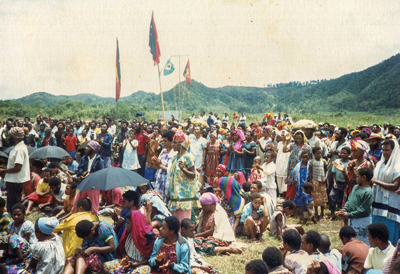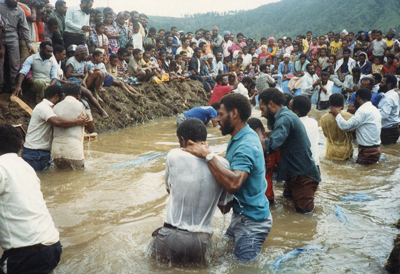42. The peace baptism |
Sven speaks: The baptisms were always performed in the rivers and were thus very public events. It was not just the church members who were present but often all the inhabitants of the villages as well. The decision to get baptized was often a very large and difficult one for the older men who were part of the village leadership. The baptism was seen as a final confirmation that they had left their old position. That meant they had to face the tribal leadership and declare that they would no longer participate in any blood revenge or other tribal battles. Generally, this was accepted but sometimes this meant that they were subjected to intimidation. Sometimes their threats were put into action and sometimes the subjects of the intimidation were beaten up quite badly. Once, there was a young woman who gave her heart to the Lord and wanted to get baptized. As she was standing in the water, waiting to be baptized, her relatives pulled her out of the water and carried her away. They did not want her to get baptized. So for some, there was a great price to pay to become a follower of Jesus. However, she did not give up and was baptized later on.
On another occasion, there was a man who had been through many tribal fights and much violence. He had several homemade rifles and before he was baptized, he made a bonfire and burned all his home made rifles and other items, used for fighting, in front of the whole tribe. The baptisms clearly showed that they had experienced salvation. I used to say that when you gave your life to the Lord, you died to your old life, and that the baptism in water was a symbolic burial of your old life. Rising out of the water was a symbolic resurrection from the grave to living a new life. When someone close dies very suddenly, it can sometimes be hard to take in that the person will not come back. The funeral service becomes the act, which brings it home to relatives and friends that this person is gone for ever. This was exactly what the nationals experienced when they got baptized to Christ. The baptism was understood as an event that symbolized that the person in question was never to return to his or her old life.
People on their way to “the Peace Baptism” The number of people being baptized each time varied. Sometimes there were just a few people who were baptized and other times many more, often around 20. During the largest baptismal service we ever held in Papua New Guinea, 97 people were baptized, Sven says. "Were believers allowed to participate in the village council?" I asked Sven. "Not very often in the beginning of the Pentecostal movement in the Highlands, he answered. The reason for this was because many of the decisions circulated around blood feuds and tribal fighting and people knew that the believers were against violence, thus it would be best not to include them in the village council." Sven continues: "Later, when several important members of the tribe were saved and when the churches were more established, the believers held a very important position in the societies. The village magistrate, the local council member, and the pastor were probably the three most important people in a village." |

There were a lot of people gathering from each of the two tribes Sven continues telling: There were two tribes who were at war with each other for a very long time, even for several years. Then it happened that both of the chief headman of each tribe gave their hearts to the Lord at the same time. It was decided that there would be a combined baptism for the two headmen and thus they were to establish peace in connection with the baptism. In other words, they were planning a peace baptism. 
All the members of the two tribes marched to a little river that was situated on the border between the two tribes. It was a great gathering there, I preached and Kundi Pok interpreted the message to the Melpa language. In connection with the baptism, the two tribal leaders embraced each other and said that they would henceforth live in peace with each other. There were a lot of others who were baptized at the same time as well. This was a unique type of peace agreement, because normally pigs and money would be given to the tribe that had lost most people killed in the fights. Such a thing did not occur in this case; instead they let the baptism be a confirmation that they had established peace between them.
The man on the far right in the photo, in front of the pastor, in the blue T-shirt, is one of the two tribal leaders. |